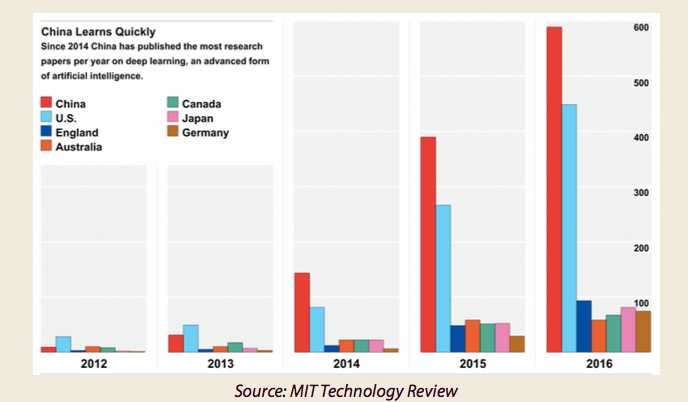From 13D Research, October 11, 2017:
As software eats the world, a dramatic shift is underway in both the technology and the doctrine of war
A new Harvard Kennedy School study concludes AI could revolutionize war as much as nuclear weapons have done. China and Russia have also reached effective technological-military parity with the U.S. But, America does not have a roadmap like China, which plans to dominate AI by 2030, while Russia will make 30% of its military equipment robotic by 2025. Putin warns: “Artificial intelligence is the future, not only for Russia but for all of humankind. Whoever becomes the leader in this sphere will become the ruler of the world.”Software is eating the world’s militaries across a range of systems — including modular digital components that can be quickly interchanged on military equipment, new drones with “bird-like agility,” and AI-powered missile systems. The key differentiator is the ability to effectively utilize the new information and increased computing capacity, highlights a Fast Company analysis, in order to improve military tactics and strategy.What are the implications? First, a dramatic shift is underway in both the technology and the doctrine of war. Software is becoming pivotal behind weapons and information systems — determining who gets the advantage.Second, the new AI competition differs from prior arms races because much of the innovation can be used for both commercial and military applications. The commoditization of drone-delivery-technology and autonomous passenger vehicles could become powerful tools for asymmetric warfare.
Third, in contrast to nuclear weapons, which still require resources and expertise in relatively short supply, improvements in AI and related technologies also make it easier for smaller nations to change the balance of international power, according to Wired. Indeed, ISIS has begun using consumer quadcopter drones to drop grenades on opposing forces.AI-defense related stocks are showing relative strength, but are trading at discounted cash flow multiples. Consider the following:China’s AI strategy is to directly link commercial and defense developments. China aims to dominate the next generation of “intelligentized” warfare, relying on “long-range, precise, smart, stealthy and unmanned weapons platforms.” In February, China opened a national lab — operated by Baidu — dedicated to making the nation more competitive in machine learning. For example, China has developed a cruise-missile system called the Long Range Anti-Ship Missile (L.R.A.S.M.), which is described as a “semi-autonomous” weapon, notes the New York Times, using AI to avoid defenses and make final targeting decisions. The weapon is part of its “remote warfare” strategy that involves building large fleets of cheap, small ships deploying missiles to attack the enemy’s larger ships, such as aircraft carriers.China has surpassed the U.S. in the number of scientific papers produced on AI — with 40% of AI research papers worldwide now published in Chinese. Chinese AI researchers have an advantage, because most also speak English and benefit from access to all research studies disseminated in English.

Many western AI researchers are not aware of THIS progress in China.For instance, last year, Microsoft proclaimed that it had created software capable of matching human skills in understanding speech. However, Baidu clarified that it had achieved similar accuracy with the Chinese language two years earlier.Andrew Ng, former chief scientist at Baidu, believes the U.S. is too myopic and self-confident to understand the speed of Chinese competition. “There are many occasions of something being simultaneously invented in China and elsewhere, or being invented first in China and then later making it overseas,” notes Ng. “But the U.S. media reports only on the U.S. version. This leads to a misperception of those ideas having been first invented in the U.S.”Russian arms maker, Kalashnikov, is launching a range of autonomous combat drones that use AI to identify, target and make decisions. In late 2014, Russia unveiled its Robotics 2025 program to develop military robots for every environment — water, air and land. Since then, Kalashnikov has created a fully-automated AI combat module — allowing it to identify targets, learn and make decisions on its own. The development raises the possibility that unlike current drones, which have some autonomous functions but still require humans, Russia’s new drones could operate entirely independently.Russia has a smaller tech industry, but retains a strong academic science tradition. Samuel Bendett of the Center for Naval Analyses believes Russia may be willing to use AI more aggressively than rivals. In Syria and Ukraine, Russia demonstrated its ability to outperform even without the most cutting-edge technology. While Russian drones are typically less expensive and have shorter ranges than those used by the U.S, they have proven extremely effective....MORE